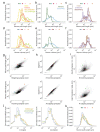This is a preprint.
Neuronal wiring diagram of an adult brain
- PMID: 37425937
- PMCID: PMC10327113
- DOI: 10.1101/2023.06.27.546656
Neuronal wiring diagram of an adult brain
Update in
-
Neuronal wiring diagram of an adult brain.Nature. 2024 Oct;634(8032):124-138. doi: 10.1038/s41586-024-07558-y. Epub 2024 Oct 2. Nature. 2024. PMID: 39358518 Free PMC article.
Abstract
Connections between neurons can be mapped by acquiring and analyzing electron microscopic (EM) brain images. In recent years, this approach has been applied to chunks of brains to reconstruct local connectivity maps that are highly informative, yet inadequate for understanding brain function more globally. Here, we present the first neuronal wiring diagram of a whole adult brain, containing 5×107 chemical synapses between ~130,000 neurons reconstructed from a female Drosophila melanogaster. The resource also incorporates annotations of cell classes and types, nerves, hemilineages, and predictions of neurotransmitter identities. Data products are available by download, programmatic access, and interactive browsing and made interoperable with other fly data resources. We show how to derive a projectome, a map of projections between regions, from the connectome. We demonstrate the tracing of synaptic pathways and the analysis of information flow from inputs (sensory and ascending neurons) to outputs (motor, endocrine, and descending neurons), across both hemispheres, and between the central brain and the optic lobes. Tracing from a subset of photoreceptors all the way to descending motor pathways illustrates how structure can uncover putative circuit mechanisms underlying sensorimotor behaviors. The technologies and open ecosystem of the FlyWire Consortium set the stage for future large-scale connectome projects in other species.
Conflict of interest statement
Competing interests T. Macrina, K. Lee, S. Popovych, D. Ih, N. Kemnitz, and H. S. Seung declare financial interests in Zetta AI.
Figures




















References
-
- Arendt D., Tosches M. A. & Marlow H. From nerve net to nerve ring, nerve cord and brain--evolution of the nervous system. Nat. Rev. Neurosci. 17, 61–72 (2016). - PubMed
-
- Ma X., Hou X., Edgecombe G. D. & Strausfeld N. J. Complex brain and optic lobes in an early Cambrian arthropod. Nature 490, 258–261 (2012). - PubMed
-
- Mesulam M. M. From sensation to cognition. Brain 121 (Pt 6), 1013–1052 (1998). - PubMed
-
- Costandi M. Anti-connectome-ism. The Guardian (2012).
Publication types
Grants and funding
LinkOut - more resources
Full Text Sources
